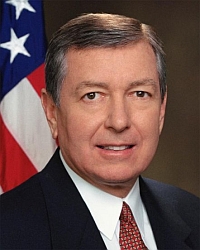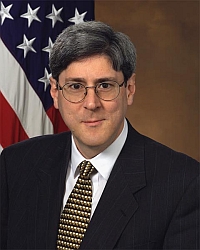Last week the House Judiciary Committee conducted two further hearings into the formulation of Bush Administration torture policy. In the second, John Ashcroft was questioned and some significant progress was made. Ashcroft acknowledged that the White House had effectively co-opted the Office of Legal Counsel (OLC), and that its opinions were no longer being issued at arm’s length. While reiterating some absurd fantasies about torture (starting with the indefensible proposition that waterboarding has always been fine), he stated that it was “not hard” to rescind the original torture memorandum because it was a shoddy product.
Ashcroft failed to present a comprehensive account of the origins of the torture memo but, as Salon’s Mark Benjamin quickly noted, he did undermine the narrative that Michael Mukasey, John Yoo and others have used to support the OLC memos—namely that they were a good-faith effort to answer legal questions. In fact, as we are likely to learn in greater detail soon, many of the torture techniques encompassed in the Bush Administration’s “Program” were in active use before the first OLC memo was sought. These memos were not prepared to dispense advice because the green light was already lit. Rather, they were made to order after the fact, to furnish a “golden shield” against criminal prosecution. As Jane Mayer recently demonstrated, the “Torture Team” members were focused on their criminal culpability almost from the outset.

However, the hearings have been undermined by a careful campaign that merits some examination.
Professional magicians and confidence artists share a few professional techniques, and one of them is known as “the misdirection.” At a key moment when a stunt is being pulled off, the artist will arrange a diversion to insure that the viewing public’s attention is focused elsewhere. The trick can then be pulled off with minimal risk of discovery. Watching Republican witnesses and committee members perform in Congressional committees in the past few weeks, it pays to be conscious of this practice. In an effort to avert attention from White House practices—especially its torture and surveillance policies–Bush Administration friends and emissaries on the Hill focus on carefully prepared and coordinated diversions. Their objective is plain enough: run out the clock, confuse the audience which is trying to follow a complex series of facts and figure out what this is all about, and help keep the public in the dark about what went on.
The questions that the Congressional investigators want answered are fairly simple. Who is responsible for torture policy? What caused it to begin? Exactly how was it pushed through over strong opposition from career professionals in the uniformed services, in the intelligence community, and among lawyers in government service? Were the authors of these policies aware that what they were doing would be viewed in the United States and around the world as criminal conduct? These are deadly serious issues which have done immense damage to America’s reputation around the world and which make it increasingly difficult for America’s allies to work with us. But for the misdirection artists, these questions will be obscured or turned into buffoonery.

On Tuesday, Rumsfeld’s former number three in the Pentagon, Doug Feith, made his long-awaited appearance on Capitol Hill. Feith is the man who brought you the war in Iraq and the Office of Special Plans that generated alternate-reality intelligence analyses designed to make it possible. He was Paul Wolfowitz’s boy, but he had remarkably few friends in the Pentagon, and indeed, one of his powerful detractors, former CENTCOM commander General Tommy Franks, hung on him the moniker that gets used at almost every mention of his name: “the fucking stupidest guy on the face of the earth.” Feith previously stood up the Judiciary Committee, stating that he would not attend its hearing because he didn’t like one of the other witnesses (a hitherto unknown justification). At length, Feith had to be subpoenaed to appear. But before Feith could get off a word, his designated defenders were busy at work attempting to put a stick in the wheel.
“Objection!” trumpeted designated-harasser Steven King of Iowa. What exactly did this alert parliamentarian find so objectionable? It was the chair’s claim of unanimous consent to recess the meeting to allow members to vote. After some colloquy, it appeared that Rep. King really didn’t have an objection. He was trying to slow things down and disrupt the hearings, and he and his colleagues succeeded in just that, repeatedly. His back-up, Rep. Darrell Issa of California, peppered the chair with “points of parliamentary inquiry”–which never actually raised any parliamentary inquiry, but brought the proceedings to a stop and allowed him to make a speech.
The carefully laid-down cover fire clearly was designed to benefit Feith, a weak witness with a curious and highly selective memory.
Then Feith blasted forth his own accusations, targeting fellow witness Philippe Sands. In his recent book The Torture Team, the British barrister and law professor reconstructed the team of lawyers who played a key role in introducing the Bush Administration’s torture policies. Feith plays a key role in the book, much of it drawn from an extensive interview that Sands conducted with him, but other aspects based on the accounts of those who worked with Feith, such as General Richard Myers, chairman of the Joint Chiefs of Staff during the period in question. Even before the hearing commenced, the neocon-aligned New York Sun lambasted Sands using language curiously similar to the written statement that Feith himself submitted to the Judiciary Committee a few hours later. The Sun wrote that is Feith “is alleged in a new book… by Phillipe [sic] Sands, to have essentially invented the legal argument that the legal protections of Common Article III [sic] of the Geneva Conventions did not apply to Al Qaeda or Taliban prisoners of America.” But the morning of the hearing, Feith took a number of direct swipes at Sands, saying that his book showed “astonishing carelessness or recklessness,” a “weave of inaccuracies and distortions,” and “sloppy research, misquotations and unsubstantiated allegations.”
When pressed to identify the “misquotations,” “inaccuracies” and “distortions,” Feith suddenly became quiet and vague. He insisted that Sands had portrayed him as the “author of the decision to deny Common Article 3 protections.” However, Sands actually says nothing of the kind. In Sands’s book, Feith is an important player, because of his position as Undersecretary of Defense for Policy, but the key legal policy determinations are made by a group which called itself the “War Council” and which had at its center David Addington, Jim Haynes, and John Yoo.
Still, Feith clearly played a focal role in the process. During the May 11, 2004 Senate Abu Ghraib hearing, Feith’s colleague Stephen Cambone testified that “overall policy for the handling of detainees rests with [Doug Feith], by directive.”
Moreover, the key policy issue that played out in the Pentagon during this period was simple: should the Guantánamo detainees have the benefit of Common Article 3 (or any other rules of international law establishing minimum rights)? That is to say, could they be tortured or subjected to other highly coercive interrogation techniques? The full inside story of the battle has yet to be told. But we do know that the career military lawyers, the JAG corps, and a handful of political appointees such as Navy general counsel Alberto Mora and assistant secretary for detainee affairs Matt Waxman argued for good-faith application for Common Article 3, while Jim Haynes, David Addington, and John Yoo took the contrary position.
In his testimony before Congress, Feith said he was “receptive to the idea that Common Article 3 should be used.” This is very curious, because no documents have appeared showing that Feith advocated that Guantánamo detainees be given Common Article 3 rights, and none of the other players in this process records Feith as supporting Common Article 3’s application. Since he was the responsible officer for policy, and this was ultimately a policy decision, Feith’s comments look suspiciously like a hearing-room conversion.
But Feith targets Sands’s book and says he was misquoted. I re-examined the book and took it a further step. Sands and Vanity Fair, which published the first excerpts of the book, state that the Feith interview was in fact recorded. I asked Sands for a transcript of the interview with Feith, which he agreed to provide to provide to me simultaneously with his delivery of a copy to the Judiciary Committee. I then tested the book text against the interview. Distressing as it may be to Feith, the book faithfully and accurately reproduces what Feith said in the interview.
The closest thing that Feith finds to a mistake is really more in the nature of a pedantic quibble: he made a distinction between Al Qaeda and Taliban detainees, he says, and was “receptive” to the idea of Geneva protections for the Taliban detainees. But when he was pressed by Sands on whether Guantánamo detainees should have Common Article 3 rights, here’s what Feith says:
The point is that the Al Qaeda people were not entitled to have the Convention applied at all, period. Obvious. I don’t see a lawyer that could make an argument of the contrary.
Based on this, Sands—who is writing a book focused on the treatment of an Al Qaeda detainee, Mohammed Al Qatahni—records Feith as opposing Common Article 3’s application. That is the obvious and inevitable import of Feith’s statement. Moreover, turning from what Feith said in the hearing room to what he did as Donald Rumsfeld’s senior deputy, we find that, as a matter of policy, he signed off on a host of techniques that contravened Common Article 3. This includes not simply the techniques like waterboarding, long-time standing, hypothermia, and sleep deprivation which belong to the core repertory of the “Program,” but even lesser practices which became common fare at Guantánamo: the use of military dogs to induce fear, forced grooming, forced nudity and hooding, the use of sound-and-light techniques.
Feith indeed faded into imbecility when these techniques were discussed, offering up the most quoted one-liner of the day: “removal of clothing is different than naked.” When pressed, however, Feith was unable to explain how “naked” meant something other than “being without clothes.” No doubt a clarification would have entailed the disclosure of the most highly classified national security information that the Bush Administration holds, namely, that the emperor has no clothes. But Feith was clear that many of these techniques could be used, indeed, he considered them to be “humane.”
This is but one chapter in the misdirection played out through the course of the hearing. It was quickly followed by Issa, King and Feith performing a trio with variations on the subject of whether Al Qaeda terrorists were entitled to Prisoner of War (POW) protections.
Was someone arguing that they were entitled to POW protections? Actually, no. As Sands noted, the entire issue of POW protections arose only because of the Administration’s own rhetoric—its fixation with putting the conflict with Al Qaeda on war footing. Princeton professor Deborah Pearlstein put it well when she called the entire question a red herring. Torture is forbidden whether the prisoners are POWs or not; this is a classic case of a distinction without a difference. But it made for a perfect misdirection.


